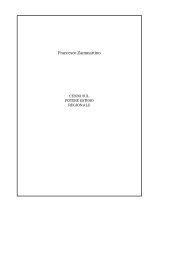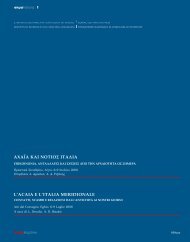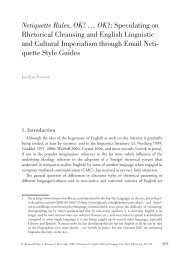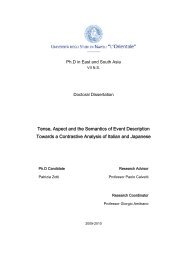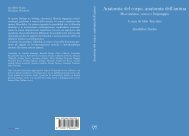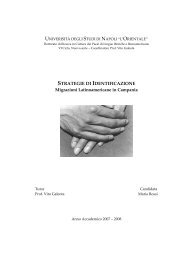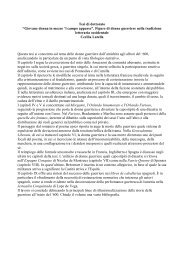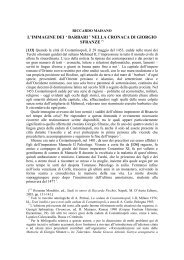Leonardo da Vinci. L'“angeLo incarnato” - OPAR L'Orientale Open ...
Leonardo da Vinci. L'“angeLo incarnato” - OPAR L'Orientale Open ...
Leonardo da Vinci. L'“angeLo incarnato” - OPAR L'Orientale Open ...
Create successful ePaper yourself
Turn your PDF publications into a flip-book with our unique Google optimized e-Paper software.
to Dionysos, also in the representation of the Hermaphrodite.<br />
We couldn’t establish if a similar report, together with a ‘map’, a<br />
drawing of the reliefs, the attribution of the temple of Elephanta<br />
to the worship of Dionysos, and even a small sculpture of the<br />
Ardhanarishvari, had come to Rome around 1513, and to<br />
<strong>Leonardo</strong>. But, if it happened, it would have wonderfully confirmed<br />
the humanist renaissance of the myth of the Androgynous,<br />
in the neoplatonic, the orphic and hermetic traditions, as shown<br />
by such a text as the Pimander, which was translated into Latin<br />
by Marsilio Ficino, and then into vernacular by Tommaso Benci,<br />
a <strong>Leonardo</strong> early acquaintance; or even in Philo of Alexandria,<br />
popularized by the Dialoghi d’Amore of Leone Ebreo, perhaps in<br />
Rome at the time <strong>Leonardo</strong> was there 31 . Furthermore, the Indian<br />
representation of the Shiva Ardhanarishvari – divided vertically<br />
as half male and half female – is exactly what the late ancient<br />
world and the humanists already knew, from a lost work<br />
by Porphyrius (3 rd cent. A.D.), the De Styge, a fragment of which,<br />
quoted by the Byzantine scholar Stobaeus, describes a rock<br />
temple and a Hermaphrodite idol with impressive analogies to<br />
Elephanta and Ardhanarishvari 32 . And also other texts, known or<br />
owned by <strong>Leonardo</strong>, gave a similar interpretation of the myth of<br />
the Hermaphrodite, the perfect fusion of the two halves, male<br />
and female, as shown by the engravings of the Chronica Mundi of<br />
Hartmann Schedel (1493) to the account in Mandeville’s Tractato 33 .<br />
In <strong>Leonardo</strong>’s last works the figure of Dionysos appears in whole<br />
evidence, ambiguously disguised as the young ‘forerunner’ of<br />
Christ in the Saint John the Baptist and in the partially autograph<br />
Saint John in the Desert. This, however, does not show a desert, but a<br />
landscape of a primordial and opulent nature, with the divine figure<br />
that had already been taken, ab antiquo, as a Bacchus-Dionysos,<br />
in a singular position evocative of that of the <strong>da</strong>ncing movement<br />
of Shiva Nataraja, represented in the act of destroying and recreat-<br />
ing the World. Dionysos appears above all in <strong>Leonardo</strong>’s Angel in<br />
the Flesh, the extraordinary newly discovered drawing which is a<br />
sort of variation on the theme of the Angel of the Annunciation, indeed<br />
the shocking representation of an Androgynus with a female<br />
breast and the male organ in erection, covered by a transparent<br />
veil. The angel present himself (or herself), moving forward his<br />
arm, in the same position of the Ardhanarishvari in the most ancient<br />
Indian sculptures, coming from Mathura (1 st and 2 nd century<br />
A.D.); not relieves, but statues, that offer at the same time male and<br />
female organs 34 . He/she is the ‘forerunner’ of nothing, but just the<br />
smiling epiphany of the archetypal Androgynous.<br />
34<br />
An amazing example is the Ardhanarishvari of Los Angeles County Museum of Art, coming<br />
from Mathura (II-III Cent. A.D.), of small dimensions, about 30 cm. high. Ssee P. Pal, Indian<br />
Sculpture, vol. 1, Los Angeles: Los Angeles County Museum of Art, University of California<br />
Press, 1986, vol. 1, p. 196, n° S73; E. Goldberg, The Lord Who Is Half Woman: Ardhanarisvara in<br />
Feminist Perspective, New York, 2002, p. 28, fig. 1.3. On Shiva and Dioniso, see W. Kirfel, Shiva<br />
und Dionysus, in “Zeitschrift für Ethnologie”, LXXVIII, 1953, pp. 83-90; J. Bruce, Shiva and<br />
Dionysus: Visions of Terror and Bliss, in “Numen”, XVIII, 1971, pp. 180-209; W.D. O’Flaherty,<br />
Dionysus and Shiva: Parallel Patterns in Two Pairs of Myths, in “History of Religions”, XX,<br />
1980, pp. 81-111; A. Danielou, Shiva and Dionysus, trans. By K.F. Hurry, New York, 1982.<br />
❧ IN AGGIUNTA al testo di Nietzsche posto a esergo del presente saggio giova citare<br />
quello che Fosco Maraini scriveva nel 1937 di fronte alla statua di Shiva a Elephanta: “Nessuna<br />
statua al mondo di tanta grandezza fisica è circonfusa di tanta grandezza spirituale.<br />
‘Ciò che importa in un’opera d’arte è la profondità <strong>da</strong>lla quale sgorga’, mi pare abbia<br />
detto Joyce; qui senti una profondità che <strong>da</strong> noi soltanto pochi (<strong>Leonardo</strong>!) hanno raggiunto”.<br />
(F. Maraini, Segreto Tibet. Presentazione di Bernardo Berenson, Bari, 1951, p. 24).<br />
❧ IN ADDITION to Nietzsche’s text placed at the beginning of the present essay, one<br />
could well quote that which Folco Maraini wrote in 1937 when he saw the statue of<br />
Shiva at Elephanta: “No statue of such a physical size in the world is endowed with such<br />
a spiritual grandeur. I think Joyce once said: ‘What matters in a work of art is the depth<br />
it flows out from’. Here one perceives a depth that only a few (<strong>Leonardo</strong>!) have reached<br />
among us”. (F. Maraini, Segreto Tibet. Presentazione di Bernardo Berenson, Bari, 1951, p. 24).<br />
31<br />
See, about Leone Ebreo, R. Pescatori, “The Myth of the Androgine in Leone Ebreo’s<br />
Dialogues of Love”, in Comitatus, vol. 38 (2007), pp. 115-128.<br />
32<br />
Ioannis Stobaei Eclogarum physicarum et ethicarum libri duo, ed. A.H.L. Heeren, Gottingae<br />
apud Vandenhoek et Ruprecht, 1792, Pars I t. I, pp. 144-147 (I iv 56). (Appendix, no. 6)<br />
33<br />
Cfr. Solmi, Fonti, p. 205. In the Antiquarie prospetiche romane, a strange poem on Mirabilia<br />
Urbis addressed to <strong>Leonardo</strong> by a milanese friend of his in Rome at the end of the fifteenth<br />
century, it is recalled the statue of a standing Hermaphrodite, partially covered by a veil<br />
(vv. 51-53): “There is also a superbe hermaphrodite: / it was made by the heavenly gods,<br />
/ and is surrounded by a fine veil” (“Ecci un inclita po’ hermafrodita, / producta fu <strong>da</strong>lli<br />
superni dei, / e parte un sottil velo ha circuita”). The quotation seems to hint to an ancient<br />
sculpture (to<strong>da</strong>y in Villa Doria Pamphilio, Rome), reproduced in an anonymous drawing<br />
of a Northern Italian artist (London, British Museum), together with a Venus Anadyomene,<br />
the germinal idea of <strong>Leonardo</strong>’s Le<strong>da</strong>. see Antiquarie prospetiche romane, a c. di G. Agosti e D.<br />
Isella, Parma, 2004, pp. 54-55, ill. 16-17. See also this volume, pp. 174-175, supra.<br />
Giusto Fontanini e Apostolo Zeno, Biblioteca dell’eloquenza italiana,<br />
Venezia, 1753, Tomo I, p. 359<br />
“Ma p o f El e p h a n ta in In d i a”<br />
375



